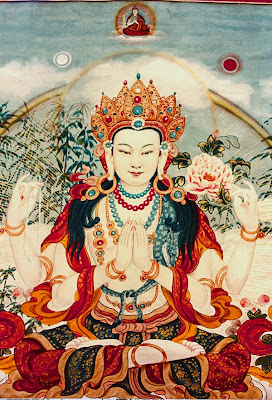Brief Daily Sadhana of Kurukulle
In the tradition of the great Terton
H.H. Jigdral Yeshe Dorje Dudjom Rinpoche (1904-1987)
Supreme Head of the Nyingma Sect of Tibetan Buddhism
1. Refuge and Bodhicitta. (recite three times)
namo
rang rik yay shay khan dro mar
du drel may par kyap su chi
ma tok nyi dzin trul pay lo
rang drol chen por sem kyay do
In the self-existing awareness as the wisdom dakini,
I take refuge beyond coming together and separation.
The confused mind of unrealized beings clings to duality.
I arouse the awakened mind of natural liberation.
2. Dorje Tsig Dun-pa
(Seven-Line Prayer to Guru Padmasambhava)
hum
ur-gyan yul gyi nub chang tsam
pe-ma ge-sar dong-po la
ya-tsan chog gi ngo-drub nyay
pe-ma jung-nay zhay su drag
kor du kan-dro mang-po kor
kyed kyi jes-su dag drub kyi
chin gyi lob chir sheg su sol
gu-ru pe-ma sid-dhi hum
HUM
In the northwest direction of the land of Uddiyana
Upon the stem and filaments of a lotus,
Is the one who has obtained all the unique and supreme siddhis,
The famous one called Padmasambhava.
Many dakinis surround him as a retinue.
I shall practice sadhana following Thee.
I pray Thee come and bestow blessings upon me.
GURU PADMA SIDDHI HUM
3. Visualization of Kurukulle, and Mantra Recitation
rang sem ma chö tong pay tsel
rik pa hri yik tro du lay
rang nyi wang dzay da ki ni
mar ser nyi ma char kay dok
chu druk lang tso dzay chak nyam
pay may chak kyu zhak pa dzin
cher mo ut pal rat nay gyen
pay nyir gar gyi gyur pak chay
day drö ö pung long du röl
tuk kar nyi teng hri mar tar
ngak kyi kor lay bar way o !
pak may zhing kün kyap par tro
ten yö ngö kün wang dü nay
tuk sok la tim zi jin kyay
day tong gyur may lhen chik kyay
rang dröl rang wang top par gyur
OM KURUKULLE HRI SOHA
From the very nature of unfabricated mind and the dynamic energy of its emptiness,
Awareness, as the syllable HRI, radiates and reabsorbs light.
From HRI, I appear as the magnetizing dakini:
Vermilion, the color of the rising sun;
Sixteen years of age, youthful and beautiful, with a passionate expression;
Holding a lotus hook and a lasso;
Naked and adorned with utpala flowers and jewels;
Dancing on a lotus and sun, and
Manifest within a vast mass of light, the bliss of meditative heat.
At the heart center, above a sun disc, a red HRI,
Encircled by the mantra, blazes with light
That radiates forth pervading all countless realms.
It magnetizes all matter, animate and inanimate,
And dissolves back into the heart life force syllable, engendering splendor and
blessings.
Changeless bliss-emptiness is coemergent.
The mastery of natural liberation is attained.
OM KURUKULLE HRI SOHA
Thus recite the mantra 1,080 times, settled in the expanse of primordial purity.Not wavering from awareness, with indwelling confidence in the view;Poised in the fundamental nature free of transition and change;When stability in natural liberation, without conceptual grasping, is attained,Mastery over all the phenomena of existence and peace is gained.Samaya!4. Dispelling the Extreme Views of Permanence and Nihilism
ho
rik pa rang shar tsen may lha
nyi may lo day chen por dal
lar yang zung juk gyu may tsel
nö chü yay shay röl par shar
om ah hung
Self-arising awareness, the deity of characteristics,
Pervades great nonduality beyond the conceptual mind.
Once again, indivisible unity, illusory dynamic energy,
Arises as the wisdom display of the universe and its beings.
OM AH HUNG
5. Dedication and Verse of Auspiciousness
ho
dü sum sak pay gay tsok kün
mik may ta dral long du ngo
kam sum kor way sem chen kün
dak nyam chen por sang gyay shok
tsa sum khan drö jin lap tu !
dak chak drup chok kor chay kyi
gal kyen kün zhi sam dön drup
dro kam dong truk tra shi shok
All virtues accumulated in the three times,
Without conceptuality, I dedicate in the expanse that is free of limits.
May all sentient beings in the three realms of cyclic existence
Awaken as buddhas in great equal purity.
By the power of the blessings of the three roots and the dakinis,
For myself and the retinue of excellent practitioners,
Pacify all unfavorable circumstances and fulfill our wishes.
May there be the auspiciousness of stirring the depths of sentient beings.
With flowers falling from the sky, everything is imbued with happiness and excellence.








































